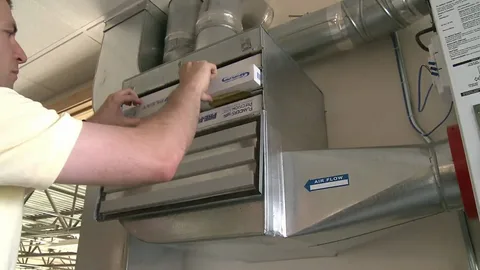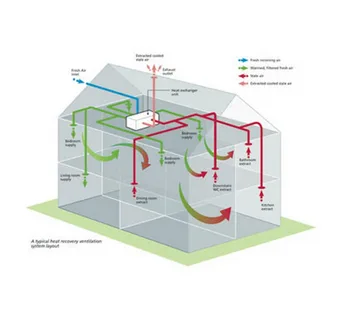Mechanical heat recovery is quickly becoming a game-changing technology in the energy sector. With the increasing demand for more sustainable and energy-efficient solutions, this innovative system offers a way to significantly reduce energy consumption and costs while minimizing environmental impact. MHR involves capturing and reusing heat typically lost during ventilation or industrial processes. This recovered heat is then used to heat or cool buildings, resulting in significant energy savings.
Understanding the Basics of MHR
MHR is an ingenious technology that leverages the heat typically lost during various activities such as manufacturing processes or building temperature regulation. The fundamental premise behind MHR is recuperating this otherwise wasted heat, reintegrating it into the system to generate additional power.
The essence of MHR lies in its ability to extract heat from air discharged from buildings or industrial processes. This reclaimed heat is then channeled into the incoming fresh air in the process or building. Essentially, the thermal energy that could have gone to waste is capitalized on to precondition the incoming air, either heating or cooling it, thereby optimizing energy usage.
With an MHR system, waste heat gets a second life, and businesses and homes can optimise their energy usage. By preventing heat from escaping into the atmosphere and putting it to work instead, MHR systems exemplify the smart and sustainable use of resources.
Mechanism behind Recovery system
Recovery systems (MHRS) operate on a remarkably straightforward yet effective principle. Essentially, these systems draw from the thermal energy from industrial processes or buildings in the outgoing air.
An MHRS usually incorporates key components such as a heat exchanger, a heat recovery unit, air-circulating fans and control systems. The heart of the system, the heat exchanger, functions as a conduit between the outgoing and incoming air streams, facilitating heat transfer without mixing the air. It recycles the thermal energy from the outgoing air to pre-condition the incoming fresh air.
By re-harnessing the otherwise wasted heat and putting it back into the system, MHRS demonstrates a sustainable approach to managing resources. Through this process, it achieves higher energy efficiency and contributes to significant energy cost savings.
Features of a Mechanical heat recovery system
A typical Mechanical heat recovery system (MHRS) is noted for its high efficiency, adaptability, and cost-effectiveness. It is a desirable addition to various sectors, including industrial settings and domestic dwellings. Central to the system is the heat exchanger, a critical component that acts as a channel, facilitating thermal energy transfer between the outgoing and incoming air streams without mixing the two.
In addition, a heat recovery unit forms a crucial part of the system. This unit essentially re-circulates the preconditioned air back into the system, assisting in maintaining a consistent indoor temperature whilst lowering the overall energy consumption.
Air-circulating fans are also part of an MHRS to ensure smooth air circulation. These fans drive the outgoing air to the heat exchanger and push the preconditioned incoming air into the system, thereby playing a pivotal role in maintaining the system’s efficiency.
The Scope of Ventilation Heat Recovery Systems
Mechanical Ventilation Heat Recovery (MVHR) systems are a specific MHR variant specially designed for application in building environments. They extract heat from the stale, outgoing air and use it to warm the fresh air being drawn into the building. This efficient recycling process optimizes energy use and enhances the air quality within the building, leading to a healthier and more comfortable indoor atmosphere.
MVHR systems hold the potential to significantly reduce the energy costs associated with heating, by making the most of the thermal energy that is otherwise lost. Their function is not limited to just heating. During the warmer months, the same principle applies but in reverse. The cooler outgoing air is used to cool down the warm incoming air, reducing the need for traditional air conditioning units and the associated energy consumption.
Such versatile applications of MVHR systems make them an ideal choice for many buildings, including residential houses, commercial buildings, and industrial facilities. Their adaptability and high efficiency drive increased adoption, making them a key player in energy conservation and sustainability.
Mechanical heat recovery Unit: A Perfect Combination
A Mechanical heat recovery Unit (MHRU) represents the pinnacle of an energy-efficient solution, merging the benefits of MHR and mechanical ventilation systems into one efficient unit. A key component of an MHR system, the MHRU is the very mechanism that retrieves, redirects, and recycles the heat energy, effectively bridging the gap between the waste heat and its productive reuse.
Constructed with a meticulously designed heat exchanger at its core, the MHRU can proficiently capture the heat from outgoing air, avoiding cross-contamination between the incoming and outgoing air streams. The MHRU then ingeniously utilizes this otherwise wasted heat to condition the fresh, incoming air, hence contributing to maintaining a comfortable indoor temperature and lowering overall energy consumption.
Integral to the operation of the MHRU are the air-circulating fans, whose task is to guide the flow of outgoing and incoming air, ensuring that the heat transfer process is as efficient as possible. Furthermore, a sophisticated control system manages the operations, guaranteeing that the MHRU is constantly functioning efficiently.
The Future of MHR
As they journey towards an era of sustainable living, the prominence of MHR systems is projected to surge. The mounting emphasis on ecological conservation coupled with stricter governmental mandates is propelling the adoption of these ingenious systems. They are integral to the larger drive towards achieving energy efficiency and environmental sustainability.
Rapid technological advancements are also reshaping the landscape of MHR. Novel innovations are making these systems more reliable and increasingly affordable, thus boosting their uptake. These technological strides are augmenting MHR systems’ efficiency, making them a viable choice for a wider range of applications, from residential buildings to industrial complexes and even transport.
Recovery Process’s Effectiveness and Energy-Saving
As they progress, they will likely witness MHR systems evolve to become more autonomous, equipped with smart features that allow them to adapt to fluctuating energy demands, optimizing energy usage. They might also see further enhancements in heat exchanger designs, enhancing the heat recovery process’s effectiveness and energy-saving capabilities.
Additionally, the synergy of MHR systems with renewable energy sources can open up new avenues, offering holistic, green energy solutions. For instance, integrating MHR systems with solar panels can increase energy-saving potential, harnessing solar power during the day and recycling waste heat during colder periods.
In the digital transformation era, incorporating data analytics and machine learning can further optimise the functioning of MHR systems, providing real-time adjustments for maximum efficiency.
Benefits of Mechanical Ventilation Heat Recovery Systems
Mechanical ventilation heat recovery systems (MVHR) work by continuously replacing stale air with fresh, filtered air, reducing pollutants and allergens, and promoting a healthier indoor environment.
Thermal Comfort
By reusing the heat from the outgoing air to warm the incoming fresh air, MVHR systems ensure a consistent, comfortable temperature inside the building, irrespective of external weather conditions.
Energy Conservation
By recycling heat that would otherwise be lost, MVHR systems significantly reduce the need for external heating sources, substantially reducing energy consumption.
Cost Savings
The energy conservation afforded by MVHR systems translates into considerable cost savings over time. By optimizing the use of thermal energy, these systems can significantly reduce the financial burden associated with heating and cooling.
Environmental Sustainability
With their ability to reduce energy usage, MVHR systems play a crucial role in minimizing carbon emissions. This makes them an environmentally-friendly solution in the quest for sustainability.
Versatility
MVHR systems can be tailored to suit various building types, from residential homes to commercial complexes, making them a highly versatile solution for varied heating and ventilation needs.
Maximizing Energy Efficiency with MHR
With soaring energy expenses and the urgent need to diminish the carbon footprint, the quest for optimal energy efficiency is more crucial than ever. Recovery systems provide a tangible and practical answer to this predicament.
Imagine capitalizing on heat energy that is ordinarily wasted and putting it to productive use. That is the ingenious mechanism behind Recovery systems. They are designed to optimise the heat transfer process, reducing the need for heating and cooling units and lowering energy consumption substantially.
Beyond conserving energy, Recovery systems also translate to considerable cost savings, making them an economically viable choice. By harnessing and reusing heat typically lost, these systems allow for the cost-effective temperature regulation in industrial and domestic settings.
Real-World Examples of Mechanical Ventilation and Heat Recovery
Several real-world instances highlight the effective use of Mechanical ventilation and heat recovery in commercial and residential buildings. A noteworthy example is the Bullitt Centre in Seattle, a building known globally for its sustainable design.
The impact of MVHR systems is not limited to commercial buildings alone. Numerous residential properties are adopting these systems to enhance their energy efficiency. By continuously replacing stale air with preconditioned fresh air, these systems ensure a comfortable and healthy indoor environment while substantially reducing energy consumption and costs.
Besides buildings, MVHR systems have found their way into various industries, including transport. For instance, heat from the engine exhaust, usually wasted in the automotive sector, is now being recovered and reused to improve fuel efficiency.
Innovative Applications of Recovery systems
The remarkable versatility of Mechanical Heat Recovery Systems (MHRS) has led to their adoption in some unexpected areas, most notably within the transport sector. In the car manufacturing industry, for instance, innovative applications of MHRS enable the recovery and utilization of waste heat from engine exhaust, thereby significantly enhancing fuel efficiency.
The adaptability of MHRS means that their application isn’t limited to static structures. From vehicles on the road to vessels traversing the ocean, MHRS is a valuable tool for energy optimization. By transforming waste into a resource, these applications showcase the significant potential of MHRS in diverse settings.
Such innovative uses of MHRS underscore their immense potential and flexibility. Their capacity to turn a typically wasted by-product into a valuable resource is a testament to their transformative power.
 FAQs
FAQs
1. What Is MHR?
MHR is an energy-efficient technology that recovers heat usually lost during ventilation or industrial processes and reuses it for heating or cooling.
2. How Does a Recovery system (MHRS) Work?
MHRS works by extracting heat from the outgoing air and pre-conditioning the incoming fresh air. The system typically includes a heat exchanger, a heat recovery unit, fans and control systems.
3. What Is A MHR Unit?
An MHRU is a crucial component of an MHR system that retrieves, redirects, and recycles the heat energy from outgoing air and uses it to condition incoming fresh air.
4. How Does A Mechanical Ventilation Heat Recovery (MVHR) System Function?
MVHR systems continuously replace stale air with fresh, preconditioned air, enhancing air quality and ensuring a comfortable indoor temperature.
5. What Are The Benefits Of Using An MHRS Or MVHR System?
Both systems significantly enhance energy efficiency, result in cost savings, improve indoor air quality and contribute to environmental sustainability by reducing carbon emissions. They are versatile, suitable for residential and commercial buildings, and industrial processes.
Conclusion
The quest for a sustainable future is both urgent and necessary, and Recovery systems are proving to be a vital part of the solution. By recycling and reusing previously wasted heat, they optimise energy usage, curb carbon emissions and yield substantial cost savings. Their versatility and adaptability mean they can be employed across many sectors, from industrial processes to residential and commercial buildings, and even the transport industry. These systems aren’t just an investment in energy efficiency but an investment in the planet’s future. By leveraging technology to harness the full potential of heat energy, they can reshape the approach to energy consumption, moving towards a more sustainable, efficient and cost-effective model.
| Related Business Listings |
| Contact Directory |
| Local Business Profiles |

